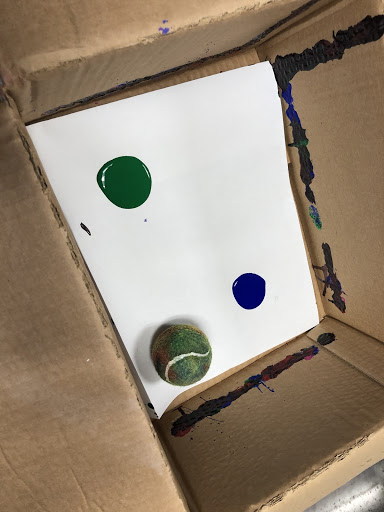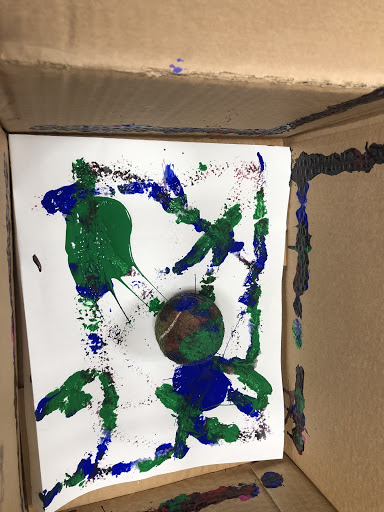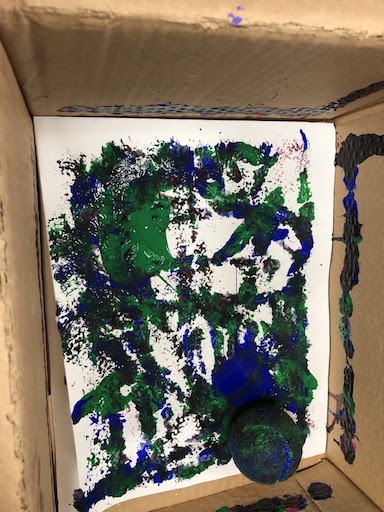What Lines Can Communicate In Painting
The Elements of Art: Line
Grade Level: 1-2
Students will be introduced to 1 of the basic elements of art—line—by analyzing types of lines used in diverse works of art to help students understand how artists use line to convey motion and mood. They will and so create an abstruse line fine art piece based on an action they enjoy to practice or watch.

Frank Stella
American, born 1936
Jarama 2, 1982
mixed media on etched magnesium, 319.9 x 253.9 x 62.8 cm (125 fifteen/16 x 99 15/sixteen ten 24 3/four in.)
National Gallery of Fine art, Souvenir of Lila Acheson Wallace
Curriculum Connections
- Performing Arts
Materials
- Smart Lath or figurer with ability to projection images from slideshow
- Variety of art media for students to choose from (suggestions: markers, watercolors, colored pencils, colored newspaper for collage, oil pastel, tempera paint, yarn, etc.)
- A long cardboard box
- Minor balls in a multifariousness of sizes
Warm-up Questions
If this painting could move, would information technology motion quickly or slowly? Is there something nearly the lines that make you think and so?
Background
Line is a mark fabricated using a drawing tool or castor. At that place are many types of lines: thick, sparse, horizontal, vertical, zigzag, diagonal, curly, curved, screw, etc. and are frequently very expressive. Lines are basic tools for artists—though some artists testify their lines more than others. Some lines in paintings are invisible—y'all don't actually see the nighttime mark of the line. But they are there, shown in the style the creative person arranges the objects in the painting.
Artist Frank Stella is a racing fan. This metal relief painting, Jarama Ii, is named subsequently an car racetrack exterior Madrid, Spain. Here, Stella used winding, curving strips of metallic painted in bright, dynamic colors to forcefully bear the motion and excitement of professional racing.
Guided Practice
Lines in art express unlike things. View the slideshow below and have students answer the questions beneath each paradigm:
Slideshow: Exploring Lines in Works of Art
Activeness
Students will select an activity they enjoy watching or participating in that involves movement such equally playing a sport, dancing, climbing a tree, biking, jumping rope, etc. They will listing adjectives that describe both the action and feelings they have while doing or viewing this activity. Then, students will write next to each adjective what blazon of line and color would reflect this activity best. For instance, watching a ballet may be soft, thin, wavy lines in pastel colors, while jumping rope may be thick, zigzag lines in assuming hues. Using Stella's Jarama 2 as their inspiration, students will create an abstract line fine art piece in a medium of their choice that evokes the feeling of their action. Remind students that pick of media is very important; markers create a much bolder impression than watercolors so they should think almost the whole picture they wish to depict.
To accommodate visual impairments, students can use yarn and glue to create their abstruse line drawings. Students can depict with gum onto a slice of newspaper, then lay unlike types and lengths of yarn to create a raised surface cartoon.
An alternative to accommodate motor control differences would be to create an abstract line drawing using a box, assurance, and tempera paint. Students would place a piece of paper inside a long box, and squeeze 3-4 quarter-size amounts of tempera paint in different colors onto the paper. Students would then use balls of varying sizes and roll the balls through the paint, trying unlike speeds, to create lines.

Place a piece of newspaper inside a box, and put 3-4 quarter-size amounts of tempera paint in different colors on the paper.
Extension
Students will so post their finished works of art for class discussion. Start, their boyfriend classmates should approximate what activity is existence depicted and give their reasons for their answer: What is information technology near the shape of the line? the thickness? the number of lines included? the color? option of media? Then the student artist will justify their decisions to the form.
The Elements of Art is supported by the Robert Lehman Foundation
National Cadre Arts Standards
VA:Cr1.1.2 Brainstorm collaboratively multiple approaches to an fine art or design problem.
VA:Cr1.2.2 Make fine art or design with various materials and tools to explore personal interests, questions, and curiosity.
VA:Cr2.1.2 Experiment with various materials and tools to explore personal interests in a work of fine art or pattern.
VA:Cr2.two.1 Demonstrate safe and proper procedures for using materials, tools, and equipment while making art.
VA:Cr3.1.2 Hash out and reflect with peers near choices fabricated in creating artwork.
VA:Re7.2.ii Perceive and describe artful characteristics of one's natural world and synthetic environments.
VA:Re8.1.2 Translate fine art past identifying the mood suggested by a piece of work of art and describing relevant subject affair and characteristics of form.
Source: https://www.nga.gov/learn/teachers/lessons-activities/elements-of-art/line.html
Posted by: washingtonlaze1962.blogspot.com










0 Response to "What Lines Can Communicate In Painting"
Post a Comment